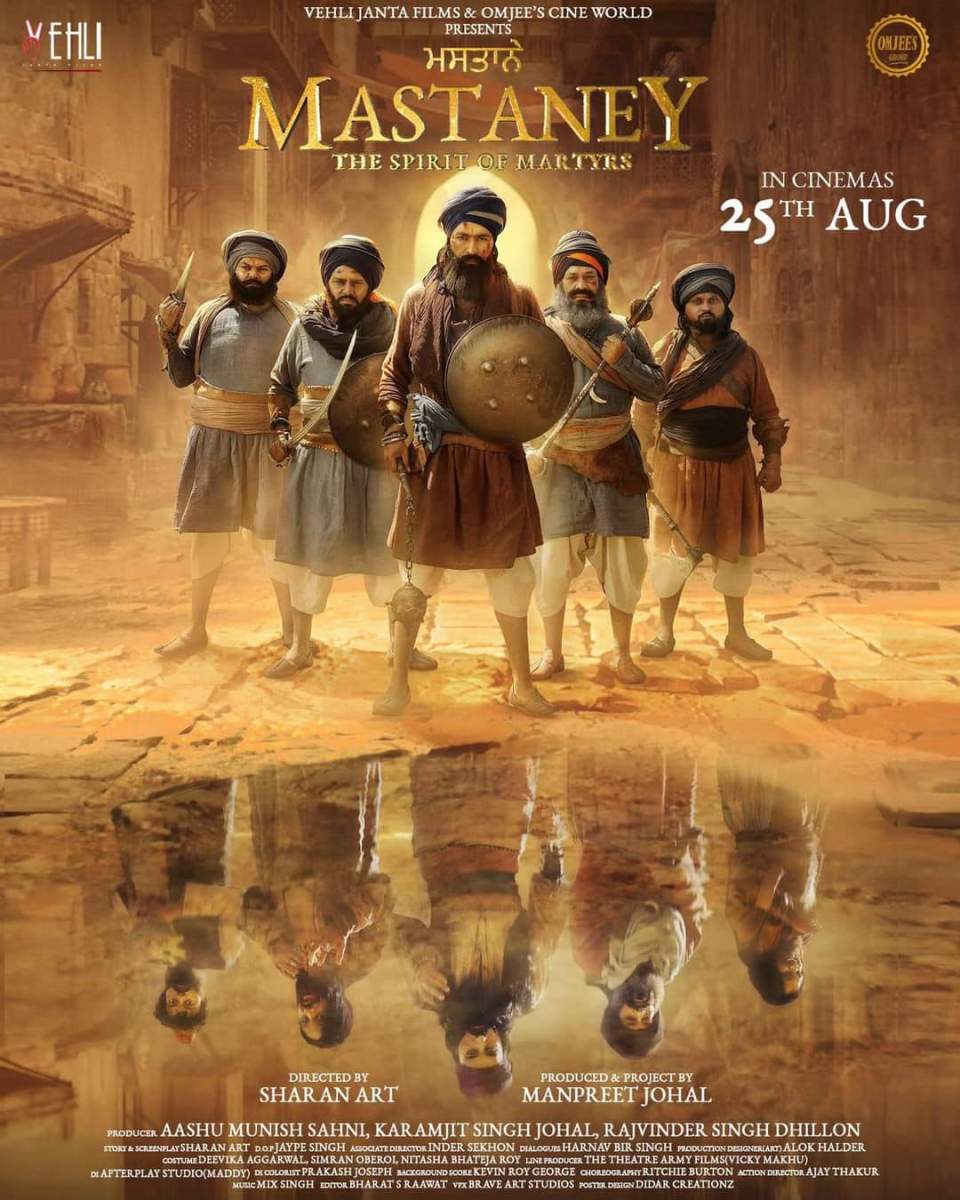
Truly a work of ‘Art’ – Beyond Bollywood
Based on a remarkable true story, writer-director Sharan Art creates a splendid historical Punjabi film that honours not just valor, but importantly, the human values that Sikhism stands for. Comedian Gurpreet Ghuggi, Rahul Dev deliver their career best performances. Simi Chahal makes a pan-India impression.
Rating: ⭐️⭐️⭐️⭐️ (4 / 5)
By Mayur Lookhar
In the age of pan India, it is generally few South Indian films that have transcended boundaries and earned national/international fame. Other regional cinema, especially the Northern belt, and even Bollywood, has largely struggled to make an impression down south. One was intrigued when Mastaney [2023] became the first Punjabi film to also have dubbed versions in Tamil, Telugu and Malayalam. The trailer was impressive and how could this reviewer not dive into the world of writer-director Sharan Art’s Mastaney.
At first, we assumed that this film will cater around the Mughal-Khorasan conflict with Persian emperor Nadir Shah annexing the Delhi sultanate from Mughal king Muhammad Shah. One, however, was surprised by the principal plot that doesn’t involve any conflict between these armies. Instead, it picks on an unheralded chapter in Lahorian history. Starting from the tenth century, the Islamic rule had taken over most of Hindustan.

In 1739, Nadir Shah [Rahul Dev] is shaken by the news of some Sikh rebels killing 12O Mughal soldiers in the Lahore province. He arrives in Lahore unannounced and threatens to behead the provincial head Zakriya Khan Bahadur [Avtar Gill] if he isn’t able to kill these rebels. Zakriya then threatens his wazir Afzal Shah [Arif Zakaria] to take decisive action or else, he, too, would lose his head.
Years of Islamic tyranny has driven out the Sikh population in the region. The few that survived are living in the woods. Such is their fear that Mughal soldiers wouldn’t step foot in the jungle. With time ticking away, the wazir comes up with a bizarre head-saving solution. Since no one has really seen the Sikh rebels, the wazir proposes to rope in some local street actors and have them paraded before Nadir Shah as Sikhs.
The lone person to have seen, or claims to have seen them is Qalandar [Gurpreet Ghuggi]. He turns away the unruly Mughal soldiers. The wazir then ropes in Basheer [Karamjit Anmol], Feena [Baninder Bunny], and Zulfi [Honey Mattu]. One look at the trio is enough to suggest that this is going to be a huge mistake. The trio is lured by money, and the luxury that they are now experiencing in the Wazir’s private property. Basheer, Feena, Zulfi strike you as Tom, Dick and Harry. They are so innocent that they aren’t even aware that they are being used as sacrificial lambs. As they say in Urdu, bakra halal hone se pehle, usey acchi tarha khilaya jaata hai [feeding goats before they are slaughtered].
After turning them down initially, Zahoor [Tarsem Jassar] gives in to the greed. He needs money to rescue his beloved Noor [Simi Chahal], who is a slave in the Lahore market.

The quintet made us wonder whether these characters are any metaphor for Punjab – the land of rivers. Panj means five and Ab is water. The opening disclaimer says that this is inspired by true stories of our legends.
From the time they arrive, one is astounded by the fact that Qalandar doesn’t really train them. Zahoor still looks like a warrior, but one fears for the innocent trio of Basheer, Feena, and Zulfi. The events that unfold in the end is the stuff of legends. The final words of the film also justify the legend.
It would be totally unfair to use the word propaganda for Mastaney. The Punjabi film does honour the Sikh valor, but more importantly, it underlines the Sikh disdain for tyranny, slavery. A true Sikh can take head, or sacrifice one to protect the honour of women and children. Those were dark times in Hindustan where barbaric invaders ransacked cities, provinces killing most Hindustani men, while enslaving their women and young children. A Mastaney simply celebrates the Sikhism spirit of martyrdom.
Sharan Art is smart to not turn this into any religious conflict. Mastaney is about empowering the oppressed and fighting the evil. Our noisy neighbour didn’t even exist then, but for 75 years, we’ve heard them repeatedly toe the two-nation theory. The Lahorian setting and the tyranny should serve as a reminder to our neighbors that one must never forget their ancient roots.
Those familiar with Punjabi language will admire the writing, dialogues. The quality English sub-titling helps the non-Punjabi audience. Barring Gurpreet Ghuggi, Rahul Dev, Avtar Gill, and Arif Zakaria, most Bollywood audiences are introduced to many talents from the Punjabi film industry.

She plays Noor, and young Simi Chahal enlightened us with her innocence, beauty and grace. The screentime may not be favorable for a popular young Punjabi super star, but no way could Simi have said no to a role/film that can propel her into national limelight. Here’s a Punjabi speaking lot in Lahore, but their characters are barely aware of Sikhs. As a slave, it is natural for Noor to be totally ignorant about the Sikhs. It tells you few things. Firstly, how the Sikhs have been driven out of their regions. Secondly, young woman like Noor being unaware of the Sikh existence is also testimony to the fact that men from this community don’t wander in the then slave markets.

Tarsen Jassar has a strong personality. One, however, is bewildered by the Jack Sparrow-like idiosyncrasies in Zahoor. The director and even Jassar goes a little overboard here. Nevertheless, being the most athletic of the quintet, Jassar displays his power at the end.
Karamjit Anmol, Baninder Bunny, and Honey Mattu play their goofy characters to a nicety. They also help to bring the Lahori humour to the fore.
Though the action choreography is well crafted, but Art would have desired a little more intensity from his lumbering troika [Bunny, Anmol, Mattu], and Ghuggi.

Gurpreet Ghuggi has made a name as a comedian. He’s often wasted in Bollywood. Who would thought that this comedian would be cast in such an intense role? Ghuggi grabs the opportunity with both hands and delivers a career defining performance.

It’s hard to recollect many representations of Nadir Shah in Indian cinema before. In 1968, actor Sheikh Mukhtar had played the titular character in filmmaker S.N. Tripathi’s Nadir Shah. Feroz Khan played one of his sons. That film though covered a different aspect in the life of the Persian emperor.
Like Ghuggi, Rahul Dev, too, delivers a career-defining performance. The experienced actor has been around for long. He’s largely struggled for consistency. Had this Nadir Shah role come earlier, Dev perhaps wouldn’t have done justice to it. He looks more rugged at 54 and this works to the character’s advantage. Nadir Shah was a man who idolised Genghis Khan and Timurlane. One can only imagine the death and destruction that followed wherever he went.
The beard has always stuck well on him and he’s always possessed a base voice. Dev though brings intimidation through his body language, and a wicked sense of humour. When he talks, there is fear all around him. That he also mutters few Farsi words, speaks volumes of the efforts that Dev has put in to play this dictator.

Arif Zakaria often does his job without much fanfare. Imagine, here’s a man who has seen the Sikh fire, then he has to confront Nadir Shah. No one epitomizes the fear of Nadir Shah better than this wazir. Afzal Shah’s predicament is a classic case of being caught between a stone and hard rock.

Veteran actor Avtar Gill must be thrilled to find a quality role at this stage in his life and career. He, too, makes this opportunity count. Surprisingly, why did Bollywood didn’t see this potential in him before?
Sharan Art picks the right cast. He adds other creativity in terms of production design. We’re told that he is a painter too. He supposedly presented a sketch of each character to the respective actor that convinced each artiste to take up Mastaney.

The scenes reflecting the horizon at a distance give a sense of the Persian influence in Lahore in 1739. Maybe, it is a little obvious, but it helps Art to showcase his artworks.

The firecrackers [imported from China] lighting up the Lahore sky with young Noor grooving to it, is a sight to behold. Qalandar is a title for saints. How could then Art’s Qalandar resist the mastana in him.
Then there’s a particular frame that shows up figures of marauding Mughal or Khorasan soldiers in the distance. They look like locusts, but it plays over a dialogue that describes these marauders as one.
Made at a budget of Rs20 crore, Sharan Art puts up a visual splendor. The fine visuals are backed by a riveting background music by Kevin Roy George that has Sufi, Persian/ Middle East flavour.
A Punjabi film has seldom left us in a spellbound. Sharan Art’s creativity, technical brilliance, astute direction is likely to make Mastaney a path-breaking film in Punjabi cinema. This one is truly a work of ‘Art’.
Mastaney is screening across theaters in the country and the globe.
Publisher: Source link
